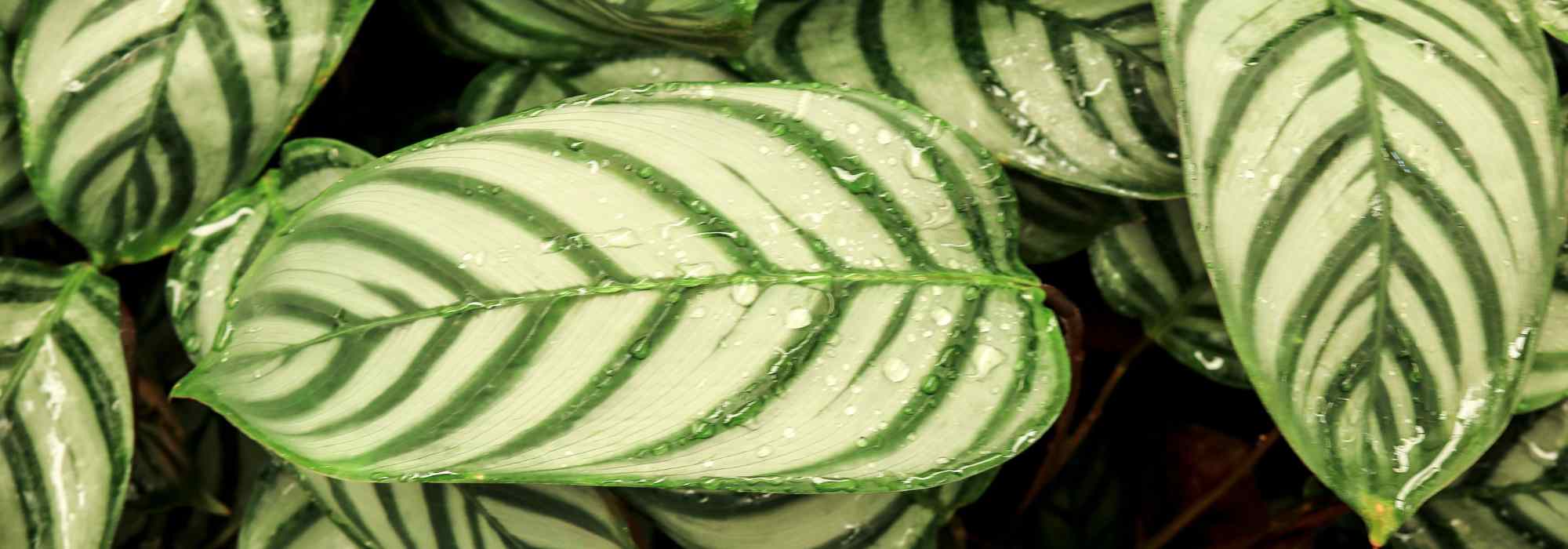
Ctenanthe: planting, growing and care
Contents
Ctenanthe in a few words
- It charms with its graphic foliage, featuring elegant patterns and often purple undersides
- Its bushy habit, with slender stems, adds a refined tropical touch
- It requires a warm, humid, and moderately bright environment, without direct sunlight
- It finds its place in a bright living room or a humid bathroom
- Better suited to experienced plant enthusiasts, it demands attentive care to thrive
The word from our expert
The Ctenanthe is a tropical houseplant with evergreen and decorative foliage, often nicknamed the “peacock plant” due to the elegant patterns and contrasting hues on its leaves. At nightfall, these leaves slightly rise before opening again in the morning, a subtle phenomenon that enhances its lively and exotic character.
Native to the tropical forests of South America, the Ctenanthe belongs to the Marantaceae family, alongside Calathea and Maranta, with which it is sometimes confused. With its spectacular foliage and elegant habit, the Ctenanthe adds a tropical and sophisticated touch to any interior, adapting equally well to contemporary décor and bohemian settings.
Demanding and requiring some care, the Ctenanthe needs a well-draining substrate, moderate watering, and a humid environment to thrive. It is essential to maintain good humidity levels with regular misting. Sensitive to drafts and overly dry air, it requires a spot sheltered from direct sunlight, in a moderately lit room.
Suited to plant enthusiasts with some experience, it rewards attentive care with lush and charming greenery. Let yourself be seduced by its graphic foliage and elegant appearance!
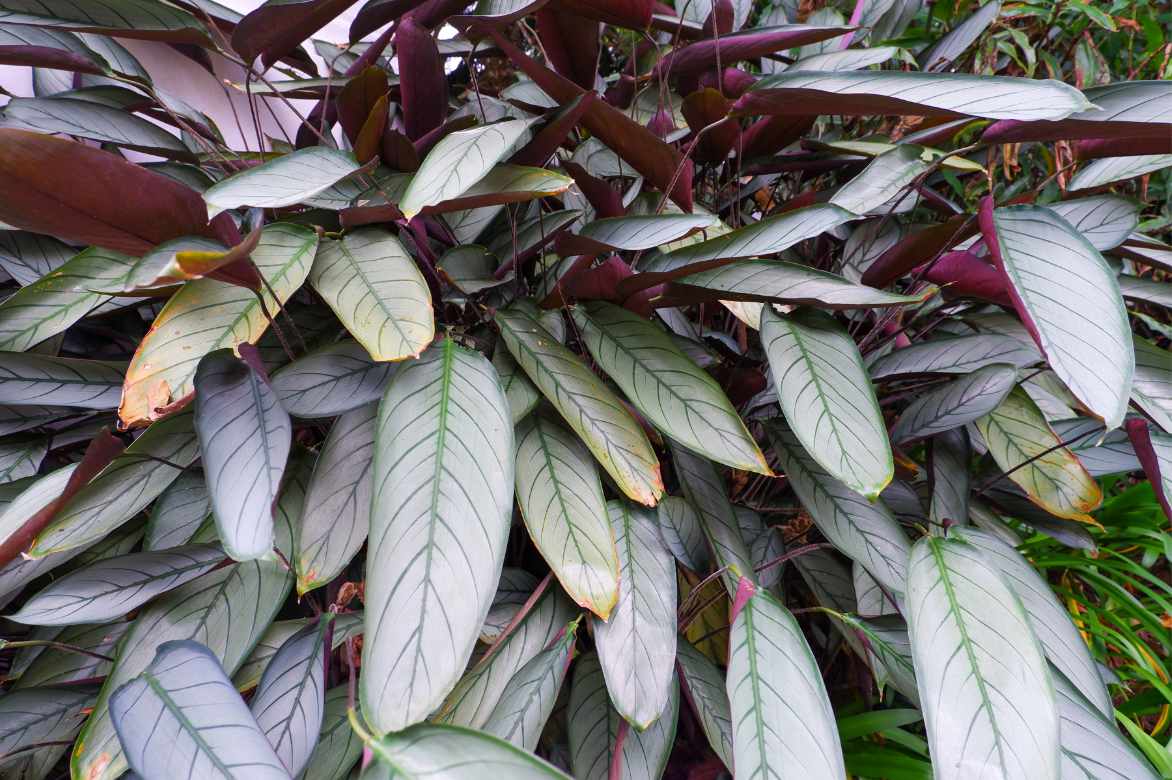
Ctenanthe setosa grown outdoors in a botanical garden
Botany
Botanical data
- Latin name Ctenanthe
- Family Marantaceae
- Common name Ctenanthe, peacock plant
- Flowering rare indoors
- Height between 50 cm and 1 m indoors
- Exposure medium to bright indirect light depending on the variety
- Soil type Light, well-draining and rich
- Hardiness Frost-sensitive
The Ctenanthe belongs to the Marantaceae family, which includes tropical plants prized for their decorative foliage and their ability to move their leaves slightly throughout the day. Its genus name comes from the Greek word “ktenos,” meaning “comb,” referring to the parallel veins prominently marked on its leaves, resembling the teeth of a comb. It is sometimes nicknamed the “peacock plant” due to the elegant patterns on its leaves, reminiscent of the bird’s plumage, as well as their slight nyctinastic movement: although less pronounced than in the Calathea, its foliage tends to orient differently depending on the light.
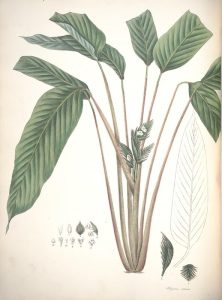
Ctenanthe setosa, botanical plate circa 1830
The Ctenanthe is often confused with two other species, the Maranta and the Calathea. Although they belong to the same family, they have notable differences, particularly in their growth habits. The Maranta grows close to the ground, forming a trailing plant indoors, while the Calathea develops leaves on short stems, giving it a more compact silhouette. The Ctenanthe, on the other hand, has longer, slender stems that grow upwards, with leaves that gracefully cascade to the sides. These distinctive characteristics help differentiate these plants, although they share similar cultivation and care requirements.
In its natural habitat, the Ctenanthe grows under the canopy of tropical forests in South America, particularly in Brazil. It thrives in the shade of trees, enjoying a warm, humid, and slightly filtered environment. These conditions make it an ideal plant for our homes or conservatories, where it finds an atmosphere close to its native habitat.
The Ctenanthe genus includes about 15 to 20 species, some of which are particularly prized indoors:
- Ctenanthe burle-marxii: elongated leaves with green and grey chevron patterns, very graphic.
- Ctenanthe oppenheimiana: large green leaves variegated with cream and a purple underside, perfect for a lush effect.
- Ctenanthe setosa: lanceolate foliage, dark green with silvery highlights and a purple underside, adding a sophisticated touch.
- Ctenanthe lubbersiana: green foliage marbled with yellow, offering a bright and original contrast.
The main cultivars are derived from these species. Ctenanthe burle-marxii ‘Amagris’ is a softer, more silvery variation of Ctenanthe burle-marxii, ideal for brightening up an interior, and it is also one of the least fussy! Meanwhile, Ctenanthe oppenheimiana ‘Tricolor’ is highly prized for its spectacular mix of green, white, and pink.
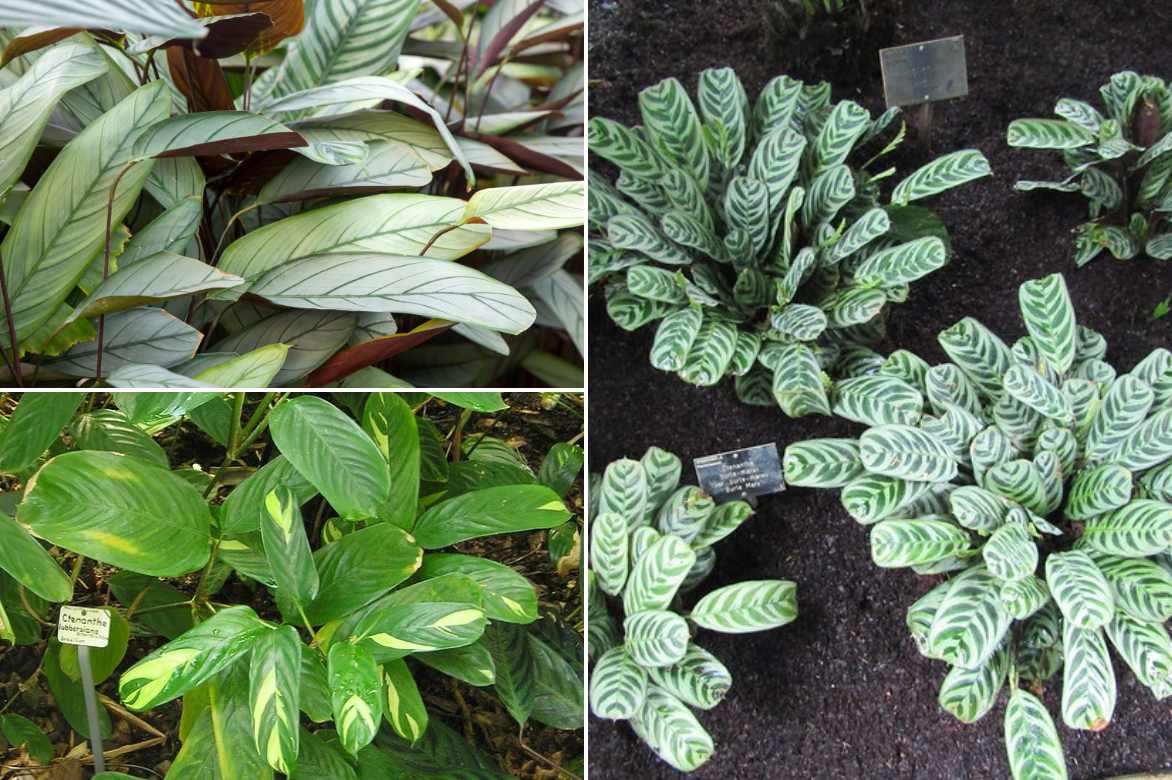
Ctenanthe setosa ‘Grey Star’, Ctenanthe lubbersiana (© Maja Dumat) and on the right Ctenanthe burle-marxii (© Leonora Enking)
The Ctenanthe is a herbaceous perennial with a bushy and slightly spreading habit, forming dense clumps thanks to its short and sometimes creeping stems. Its growth is relatively moderate but steady, spreading more in width than in height due to its rhizomatous development. Its root system consists of fleshy rhizomes that allow it to produce new shoots and gradually expand, promoting foliage density. Indoors, it typically reaches between 50 cm and 1 m in height depending on the species and growing conditions, with a similar or even greater spread.
Its foliage is the most distinctive and ornamental feature. The leaves are arranged alternately on long, slender petioles, evergreen, and elliptical to lanceolate in shape. Their texture is supple, with a slight thickness that gives them a slightly leathery appearance. The lamina features a very prominent parallel vein, characteristic of the Marantaceae family, with a prominent midrib and well-visible secondary veins running the length of the leaf. Depending on the species and cultivars, the upper side of the lamina displays a range of greens, from light to deep green, often adorned with contrasting patterns in the form of chevrons, stripes, marbling, or variegation in silver, yellow, or cream. The underside, usually tinged with purple or violet, creates a lovely contrast when the leaves move slightly throughout the day due to nyctinasty, a characteristic phenomenon of the Marantaceae family.
The flowering of the Ctenanthe is discreet and rare indoors, more frequent in its natural habitat. The small flowers, grouped in terminal or axillary inflorescences, appear as greenish or yellowish bracts, sheltering whitish to cream flowers, sometimes lightly tinged with violet. Their decorative appeal is limited compared to the foliage. Fruiting is exceptional in cultivation and occurs mainly in its native habitat, in the form of small dry capsules containing seeds, dispersed by wind or animals.
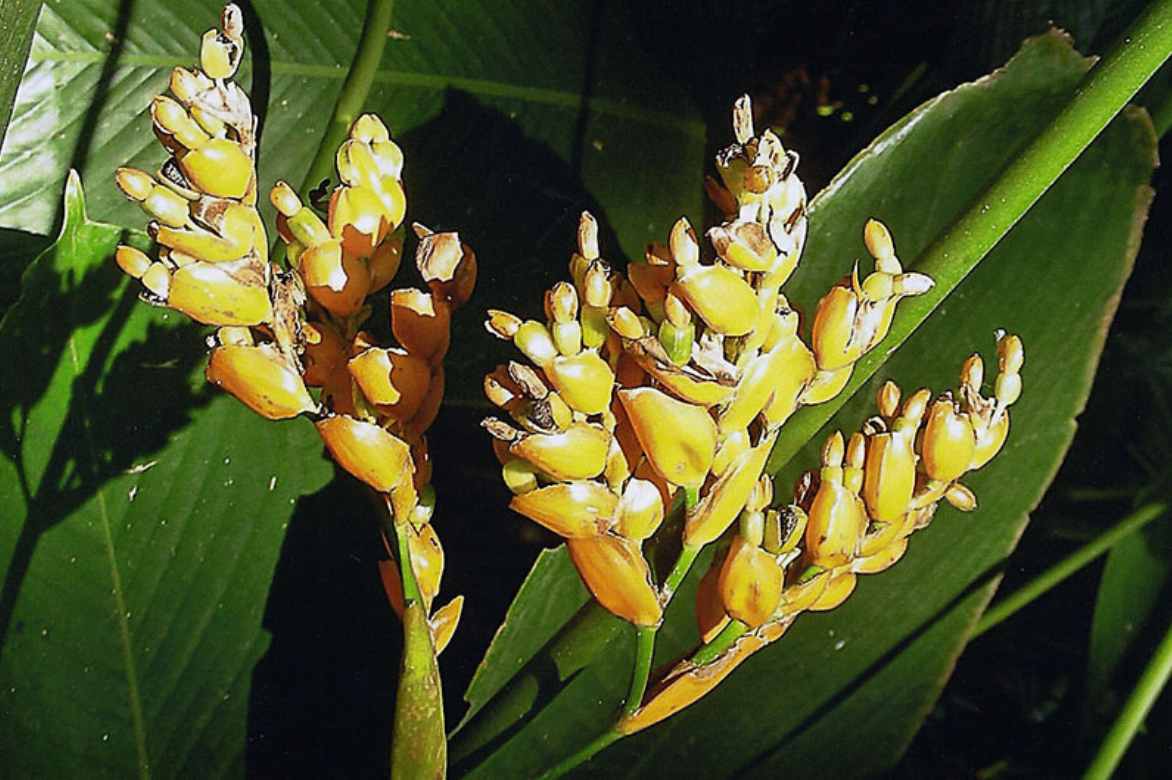
Flowering of a Ctenanthe dasycarpa (© Dick Culbert-Flickr)
Main species and varieties
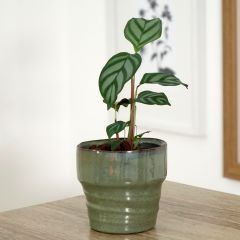
Ctenanthe oppenheimiana - Never-never plant
- Hauteur à maturité 50 cm
Cultivating Ctenanthe Indoors
Where to Place a Ctenanthe in the House?
Originating from the tropical forests of South America, mainly Brazil, the Ctenanthe is a plant accustomed to constant warmth and high humidity. This origin explains its sensitivity to cold, making outdoor cultivation impossible in temperate climates. As the Ctenanthe is a tender plant, it is grown exclusively indoors in our climates. This cultivation method allows better control of the substrate’s humidity and provides the plant with optimal conditions year-round.
Consequently, this plant can be quite demanding, as it requires precise conditions to thrive. Beware of cold drafts: it should never be exposed to temperatures below 15°C.
Like all plants in its family, it needs low-light conditions, meaning indirect light, and a humid atmosphere, otherwise the tips and edges of its leaves may turn brown. Its exposure should be without direct sunlight, which could burn its delicate leaves. It prefers filtered light, similar to that filtered by the jungle canopy. Ideally, place it near an east or north-facing window, or behind a sheer curtain if the exposure is south or west, to avoid overly intense light. Note that some varieties prefer brighter indirect light.
In the house, it naturally fits in rooms with good light and high humidity levels above 60% (around 60-80%), such as a bathroom or a well-lit kitchen. A living room or conservatory can also suit it, provided a good humidity level is maintained. Keep it away from dry heat sources like radiators, which could cause its foliage to dry out.
Its ideal temperature ranges between 18 and 26°C, conditions reminiscent of its native climate. It struggles with temperatures below 15°C and may suffer above 26°C if the air is too dry. A stable atmosphere, without sudden fluctuations, is essential to keep its foliage healthy.
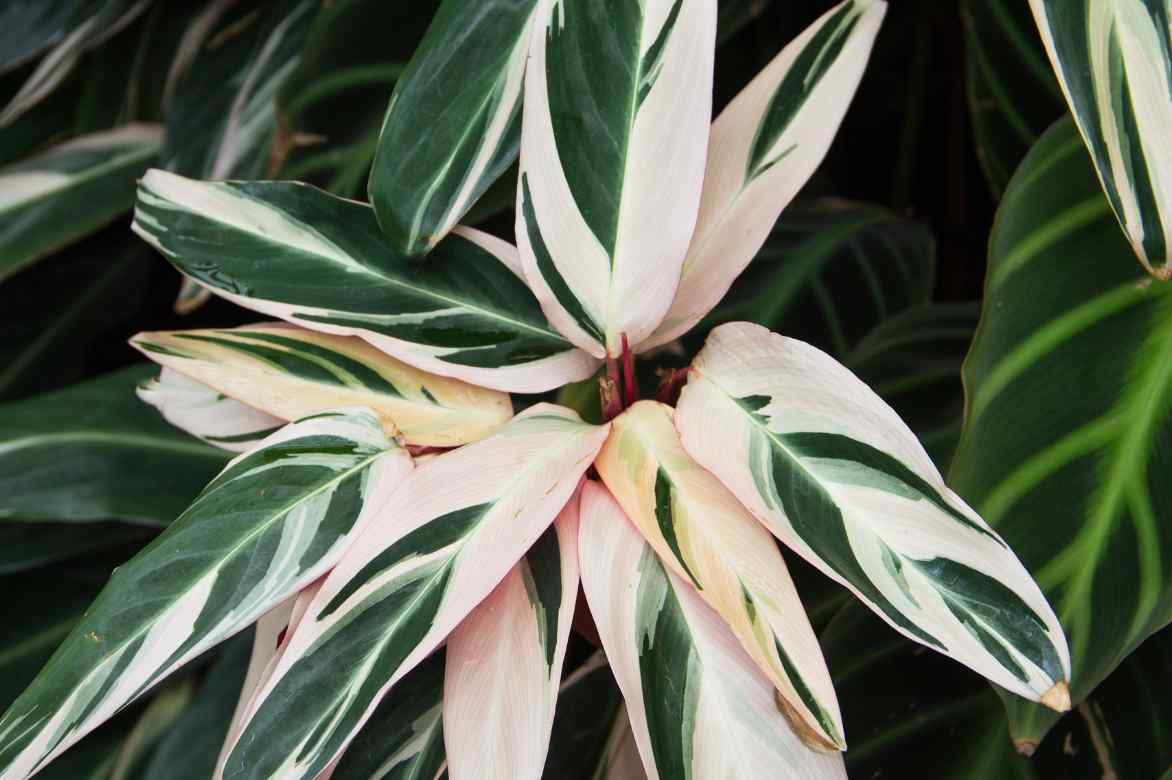
Ctenanthe Oppenheimiana
When to Plant the Ctenanthe?
Planting or repotting is preferably done in spring, between March and May, when the plant resumes active growth. This allows it to settle well into its new substrate. However, it can be planted year-round, provided extreme cold or excessive heat is avoided.
How to Plant the Ctenanthe?
What substrate?
The Ctenanthe needs a light, well-draining, and organic-rich substrate, recreating the conditions of tropical forest soil. A balanced mix prevents water stagnation while retaining good moisture. Here are the ideal proportions for a suitable substrate:
- 60% houseplant compost or indoor plant compost: provides essential nutrients and retains the moisture needed for root development.
- 20% perlite or coarse sand: improves drainage and prevents soil compaction, promoting good root aeration.
- 20% coconut coir: lightens the substrate, aids water retention without excess, and stimulates rooting.
Steps for potting:
- Prefer a plastic or ceramic pot with drainage holes at the bottom to allow water to escape.
- Place a layer of clay pebbles or gravel at the bottom of the pot to ensure proper water drainage.
- Gently place the Ctenanthe in the center of the pot, ensuring the collar (base of the stem) is not buried too deeply.
- Add the substrate around the roots, lightly tamp it down, then water with room-temperature, non-calcareous water to moisten the compost without waterlogging it.
- Place the pot on a tray of moist clay pebbles or mist its foliage regularly to recreate its natural environment.
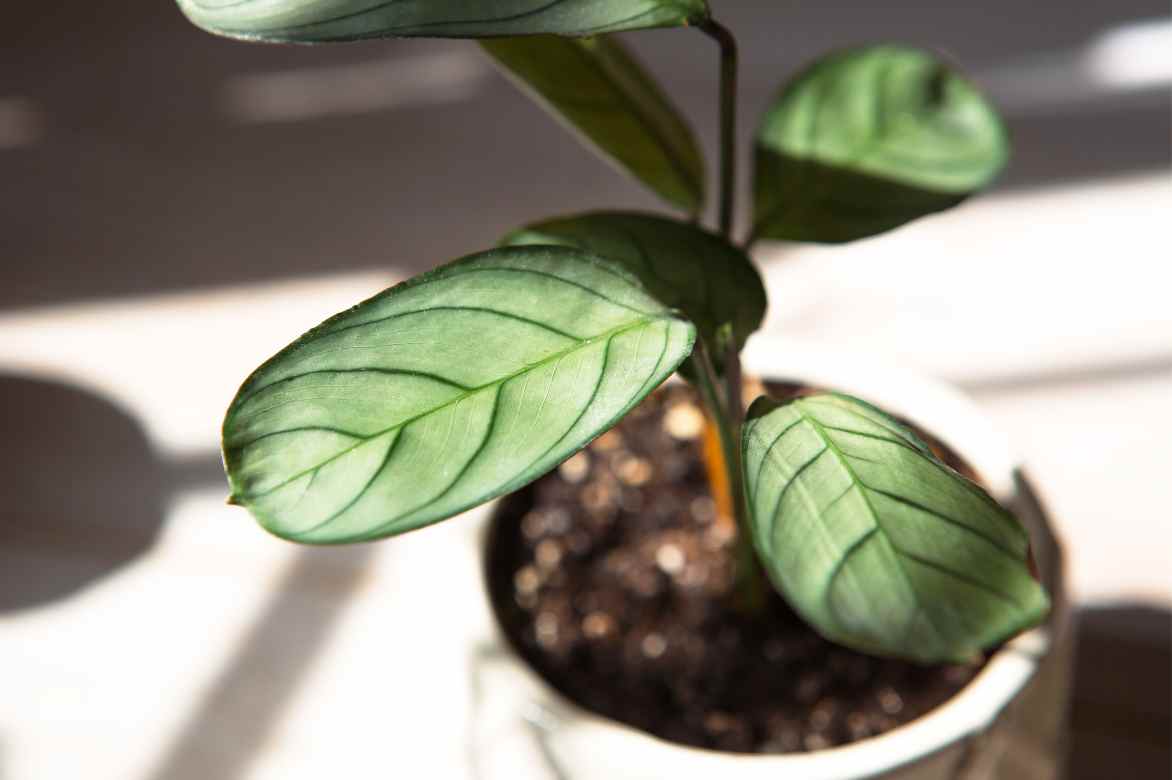
Ctenanthe burle-marxii ‘Amagris’
Cultivation and Care of the Ctenanthe Indoors
The Marantaceae family, to which the Ctenanthe belongs, is known for being finicky and demanding when grown indoors. These tropical plants require high humidity, non-calcareous water, and precise watering to prevent leaf desiccation or, conversely, root rot. Although the Ctenanthe is considered more tolerant than the Calathea or Maranta, it remains sensitive to growing conditions: overly dry air causes the leaf tips to brown, and too much direct sunlight risks scorching them. This is a plant that reacts quickly to care mistakes, which can make it challenging for beginner gardeners. However, by following a few simple rules, it adapts well to indoor life.
Watering: How and How Often?
The Ctenanthe prefers a substrate that is consistently slightly moist but not waterlogged, as its roots are prone to rot. Allow the soil to dry out between waterings. Watering should be moderate and regular, depending on the season:
- In spring and summer, water 2 to 3 times a week, as soon as the surface of the compost begins to dry.
- In autumn and winter, reduce the frequency to once a week or less, allowing the substrate to dry slightly between waterings.
Preferably use non-calcareous water at room temperature, such as rainwater or filtered water, to avoid white deposits on the leaves. It is recommended to water the substrate directly without excessively wetting the foliage to minimise the risk of fungal diseases.
Misting
The Ctenanthe requires high ambient humidity to maintain healthy foliage and prevent leaf edges from drying out. Misting is an excellent way to recreate its natural conditions, especially in winter when the air becomes drier. It is advisable to mist two to three times a week with non-calcareous water, preferably in the morning, to avoid white spots and the onset of diseases. Use a fine mist sprayer and target the undersides of the leaves. Humidity can also be increased by placing the pot on a tray of damp clay pebbles.
→ Learn more in Misting Indoor Plants.
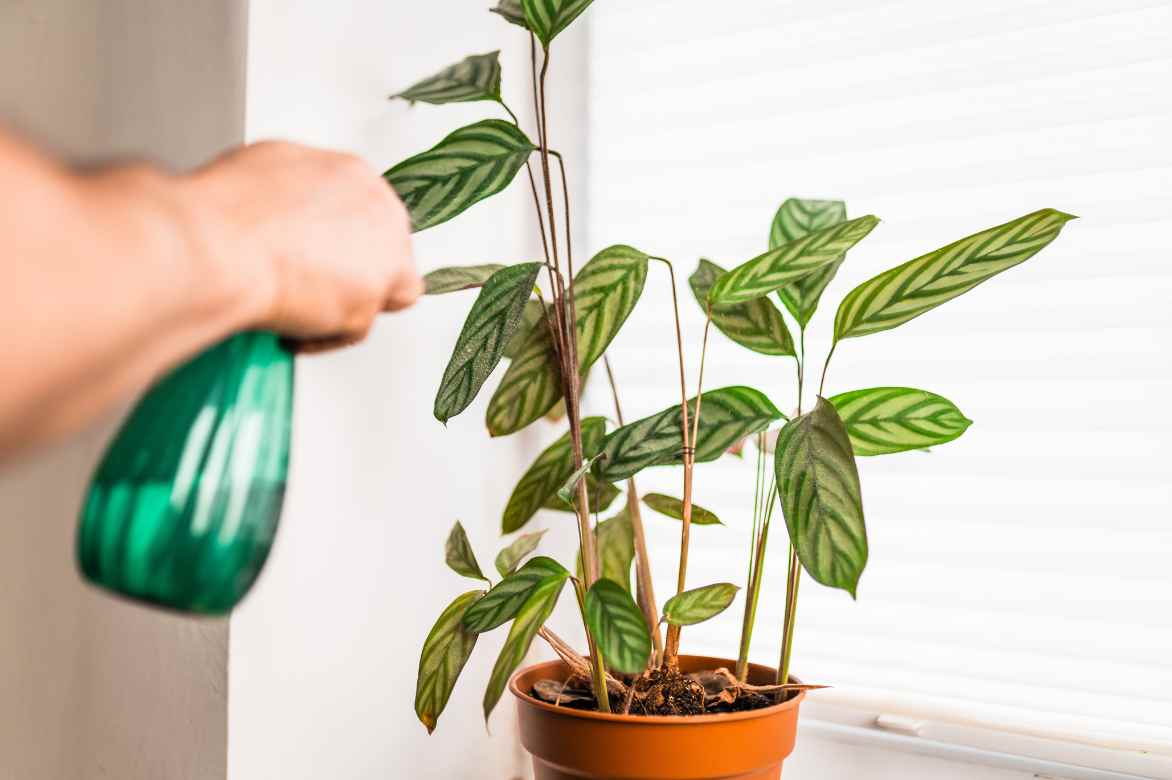
Mist your plant, especially if the atmosphere is too dry
Fertilisation: What Fertiliser and How Often?
The Ctenanthe requires nutrient supplementation to support its growth and maintain the vibrancy of its foliage.
- In spring and summer, apply a liquid fertiliser for green plants every two to three weeks, diluting it by half to avoid excess mineral salts.
- In autumn and winter, stop or space out fertiliser applications, as the plant enters a dormant phase and its growth slows.
Leaf Maintenance
The Ctenanthe does not require strict pruning, but a little maintenance helps keep it looking its best. This simply involves:
- Removing yellowed, damaged, or dry leaves to encourage the production of new shoots.
- Shaping the plant by removing stems that grow too long or become sparse.
Use sharp, disinfected scissors to prevent the spread of diseases.
Repotting: When and How?
Repotting is essential every 2 to 3 years, preferably in spring, when the plant shows signs of being root-bound (roots visible on the surface or emerging from the pot).
- Choose a slightly larger pot with good drainage.
- Replace the substrate with a fresh, airy mix (compost, perlite, coconut fibre).
- Handle the roots carefully to avoid damaging them.
After repotting, water lightly and maintain a humid atmosphere to help the plant adjust.
→ Learn more in How to Repot an Indoor Plant?
Pests and Potential Diseases
Although relatively hardy, the Ctenanthe can be susceptible to certain parasitic attacks and diseases related to growing conditions. Regular monitoring and appropriate care can prevent these issues and preserve the beauty of its foliage.
The most common parasites
- Spider mites: These tiny mites appear when the air is too dry. Their presence can be detected by a gradual yellowing of the leaves and the formation of fine webs under the foliage. To eliminate them, increase ambient humidity by misting the plant regularly and, if necessary, use a natural acaricide like diluted black soap.
- Mealybugs: They appear as small cottony clusters at the base of the leaves or on the stems. Treatment with a cotton pad soaked in 70° alcohol or a mixture of soapy water and neem oil can help get rid of them.
- Aphids: Less common indoors, they can still appear and weaken the plant by sucking its sap. A spray of soapy water can help control them.
Frequent diseases
- Root rot: This occurs due to overwatering and insufficient drainage. The roots turn black and soft, while the plant rapidly deteriorates. To avoid this issue, always use a well-draining substrate and avoid letting water stagnate in the saucer. If attacked, repotting with the removal of damaged roots is necessary.
- Brown spots on the leaves: These are often caused by excessive sun exposure or watering with hard water. It is recommended to filter the watering water and avoid direct sunlight.
- Curled or wilted leaves: This symptom may indicate a lack of humidity or water stress. It is then advisable to increase watering frequency and mist the foliage to restore a good level of humidity.
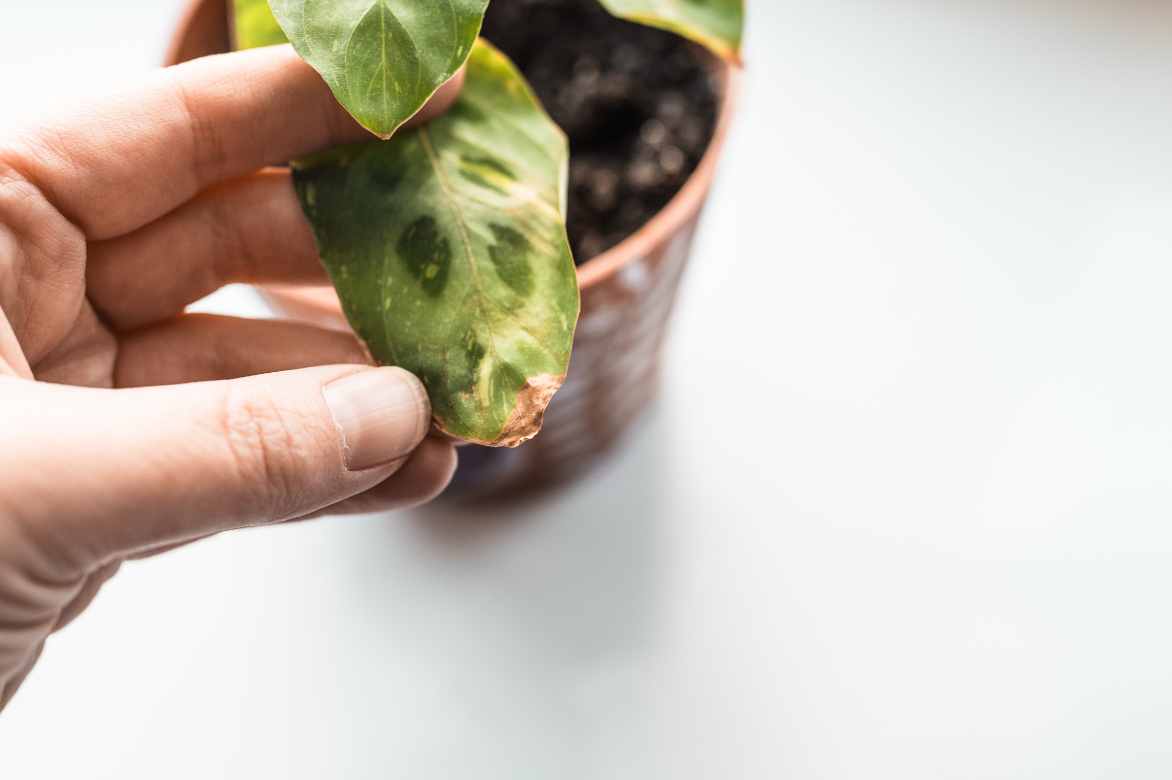
Leaves turning brown or drying out should prompt action
Propagation of the Ctenanthe
The Ctenanthe can be easily propagated by dividing the clumps, a simple and effective method that quickly yields well-rooted young plants. Stem cuttings are more delicate and rarely practised, as the plant primarily develops new shoots from its rootstock.
Dividing the clumps (the simplest and most effective method)
This technique involves separating a portion of the mother plant into several sections, each containing roots and stems. It is carried out in spring, for example during repotting, when the plant is in full growth recovery.
Steps for propagation by dividing the clumps:
- Gently remove the plant from its pot.
- Carefully loosen the soil around the roots to better see the rootstock.
- Divide the root ball into several sections, ensuring each section retains roots and a few stems. If necessary, use a clean, sharp knife.
- Immediately replant each division in a pot with a light, well-draining substrate.
- Water lightly and maintain a humid atmosphere to encourage rooting.
After division, the new plants may take a few weeks to adapt before resuming normal growth.
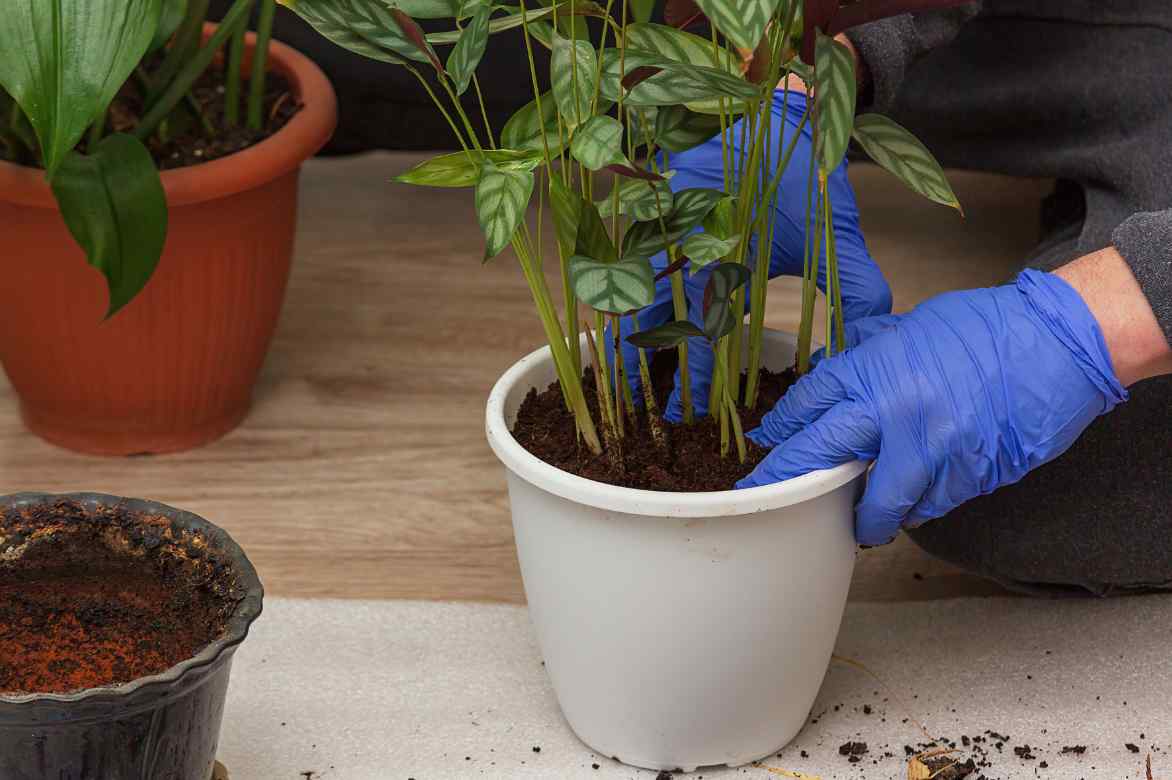
How to showcase the Ctenanthe in your home
With its graphic and elegant foliage, the Ctenanthe is an ideal houseplant to add an exotic and refined touch to your décor. Its bushy habit and varied leaf patterns make it an interesting plant, whether displayed solo or paired with other tropical plants.
To showcase it, opt for a ceramic or terracotta pot in neutral tones (white, beige, terracotta), which will beautifully contrast with its foliage. A natural fibre basket, such as rattan or jute, will enhance its bohemian and tropical allure.
The Ctenanthe thrives in a bright but filtered indoor setting, ideally near a window with sheer curtains. In a living room, it draws attention on a console or shelf. In a bathroom or kitchen, it benefits from ideal humidity while infusing a lush atmosphere.
It pairs perfectly with other plants featuring contrasting foliage: a Calathea for a jungle effect, a Monstera to play with perforated shapes, or an indoor fern to soften the overall look. Varying heights and plant textures helps to energise the space.
Would you be tempted by its elegant lushness?
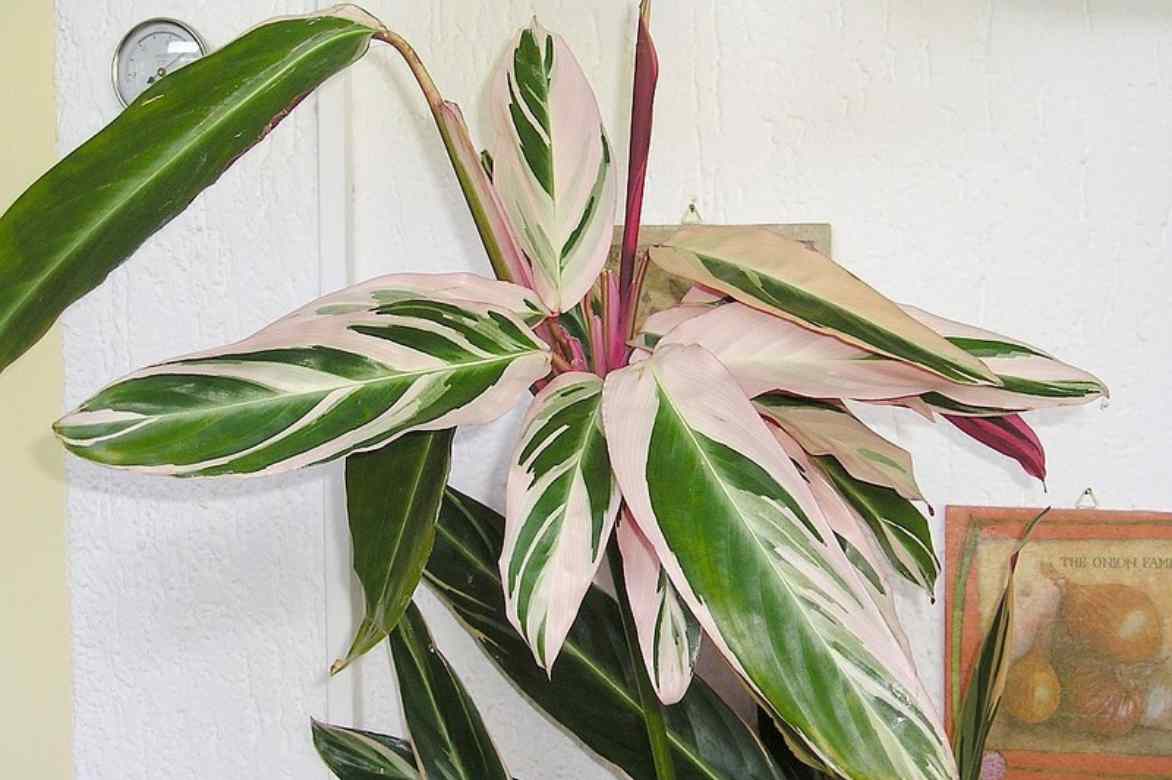
Ctenanthe oppenheimiana (Kamm Marante), © Maja Dumat
Useful resources
→ Discover our wide range of houseplants.
Frequently asked questions
-
What is the difference between Ctenanthe and Calathea?
The Ctenanthe and the Calathea belong to the same family, the Marantaceae, but they are distinguished by the shape and texture of their leaves: those of the Ctenanthe are generally more elongated and rigid, while those of the Calathea are broader and softer with more varied patterns. The Calathea is also more sensitive to growing conditions and requires high humidity, whereas the Ctenanthe is more tolerant of variations in watering and humidity. Finally, the movement of the leaves (nastic movement) is more pronounced in the Calathea, which distinctly folds its foliage at night, while the Ctenanthe exhibits more subtle movements.
-
Why are the leaves of my Ctenanthe curling?
The leaves of your Ctenanthe are likely curling due to a lack of humidity, insufficient watering, too intense light, a cold draught, or an excess of fertiliser. Mist regularly, adjust watering, and place the plant in medium to bright indirect light to avoid this stress.
- Subscribe!
- Contents
































Comments